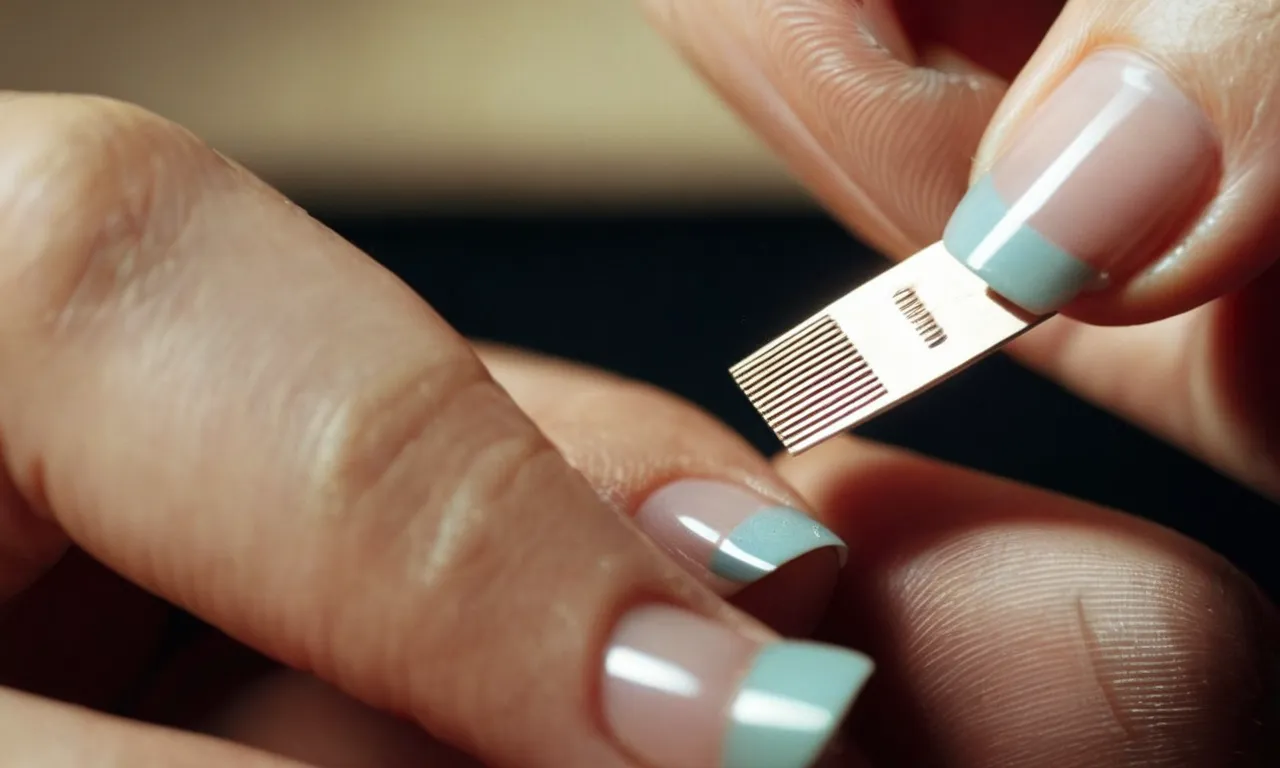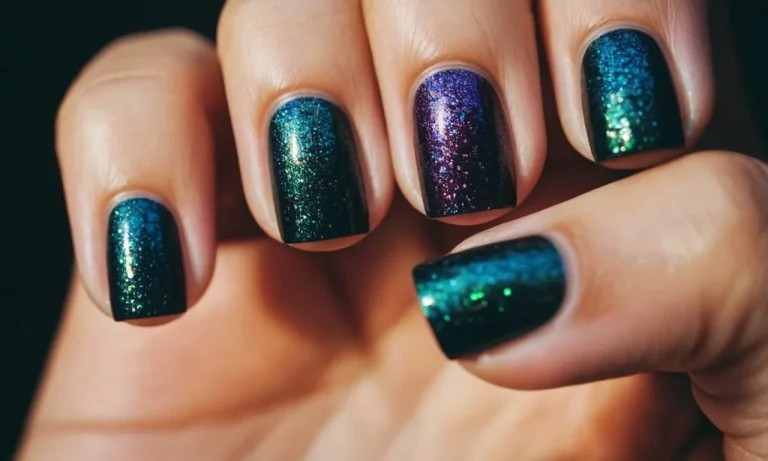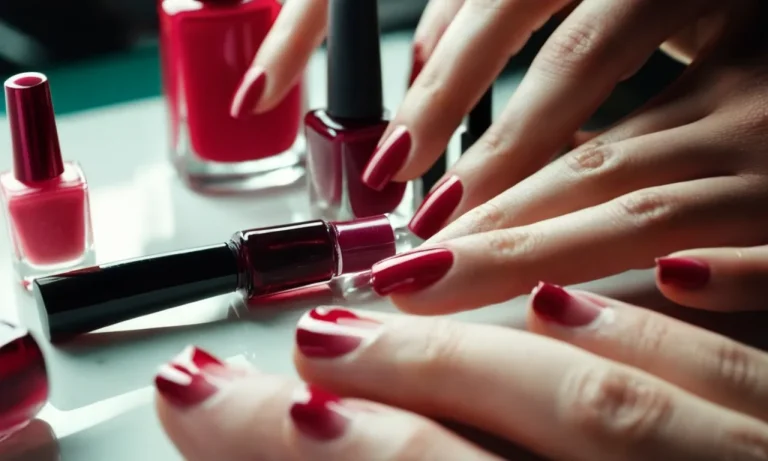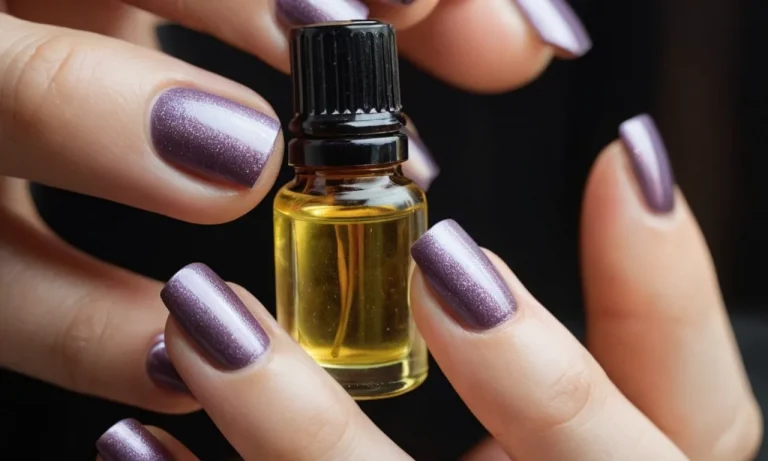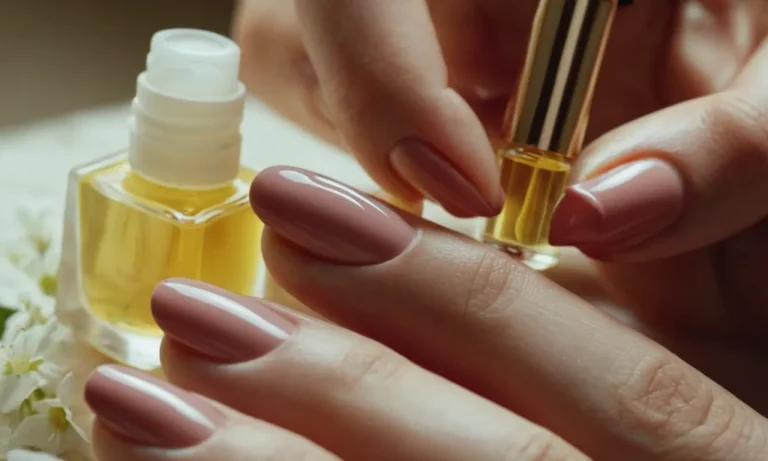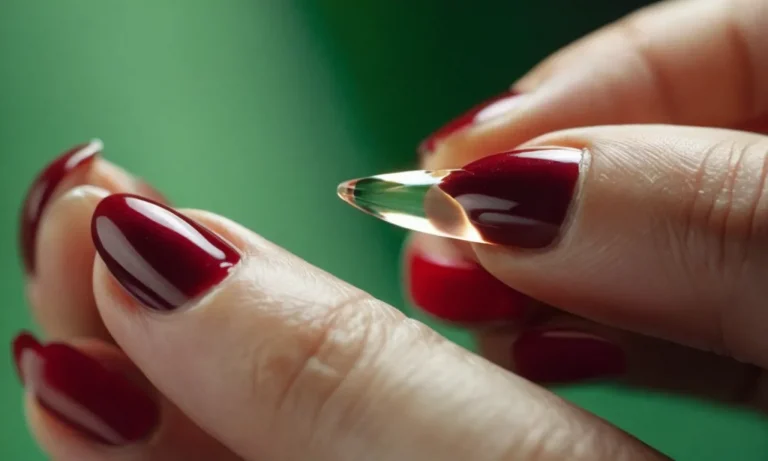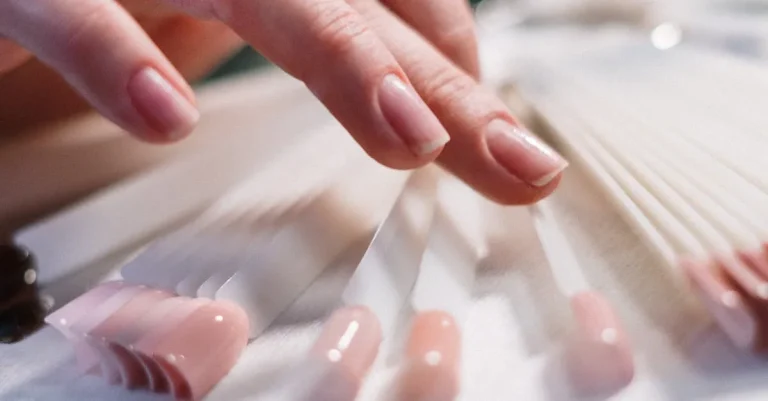How To Shape Flat Nails For A More Flattering Look
If you have naturally flat nails that tend to splinter and snag, you know how frustrating it can be to try to grow them out. The good news is there are things you can do to help give your flat nails a nicer shape.
If you’re short on time, here’s a quick answer: file the nails to round out the edges, use cuticle oil to soften the nails, and apply nail hardener to add strength and prevent cracking and peeling.
In this comprehensive guide, we’ll cover everything you need to know to help your flat nails grow healthier and stronger, with tips on filing technique, moisturizing, supplements to take, and professional nail services that can help.
Proper Filing Technique for Flat Nails
File in One Direction
When filing flat nails, it’s crucial to file in one direction rather than sawing back and forth. Filing in a single stroke from cuticle to tip helps keep the nail edge smooth. Go slowly and gently to avoid damaging the nail plate.
Filing too roughly can cause tiny snags and tears in flat nails, making them more prone to peeling and breaking. Take your time and file patiently for the best results.
Use a Fine-Grit File
Opt for a nail file with a grit of 150 or above when shaping flat nails. Coarse files with lower grits will shred flat nails and cause even more damage. A fine-grit file smooths the nail edge without getting too aggressive.
Look for crystal or ceramic nail files, as they tend to be more gentle than metal files. Gently buff each nail using short, uniform strokes in one direction.
File the Edges
Pay close attention to filing the edges of flat nails, as they tend to be weak spots. Use very light pressure along the sides to smooth away any roughness or snags. Avoid sawing back and forth, which can thin out the sides excessively.
The key is to file just enough to erase flaws and seal the layers of the nail plate without making the edges too thin or flexible. This helps prevent cracking and peeling.
Don’t File Too Thin
A common mistake when shaping flat nails is filing them too thin in an attempt to add curve or arch. While thinning the nail plate may add a bit more flex, it seriously weakens flat nails in the process. Filing too aggressively leads to peeling, splitting, and breakage.
For flat nail shapes, focus on smoothing the edge rather than dramatically thinning out the nail plate. Leave a little more thickness for strength.
With the right filing techniques, you can shape your flat nails into a gorgeous look. Using a fine-grit file in one direction while avoiding over-thinning preserves nail strength. Take it slowly and finish with a buff for nails that look and feel amazing.
Moisturize Nails and Cuticles
Keeping nails and cuticles adequately moisturized is a key part of nail care. Dry, brittle nails and cracked cuticles not only look unappealing but can lead to hangnails and infections. Using cuticle oil, hand creams, and petroleum jelly regularly can restore moisture and give nails a healthy, well-groomed appearance.
Cuticle Oil
Cuticle oil is specifically formulated to nourish the nails and cuticles. The oil conditions the skin and helps retain moisture. Many dermatologists recommend applying cuticle oil 1-2 times per day. Lightly massaging the oil into the cuticles and nail beds creates a protective barrier against harsh elements like cold weather.
Popular ingredients in cuticle oils include vitamin E, aloe, jojoba, and essential oils like tea tree or lemon. Using an oil containing antimicrobial properties can help prevent fungal infections. Quality cuticle oils absorb quickly without leaving hands feeling greasy.
Hand Creams
While any moisturizing hand cream can hydrate cuticles, targeted formulas work best. Look for creams containing ingredients like shea butter, glycerin, dimethicone, petrolatum, and ceramides. These nourishing elements soften cuticles, heal cracks, and improve flexibility.
For severely dry skin, the American Academy of Dermatology recommends creams with a petrolatum or oil base. Apply hand cream after washing hands and through the day as needed. Gently push back cuticles after applying for maximum absorption.
Petroleum Jelly
Many manicurists swear by petroleum jelly for fixing ragged cuticles overnight. Applied before bed, the thick salve penetrates cracked skin on contact. It provides long-lasting hydration by creating a protective seal that prevents moisture loss.
To use, dip a cotton swab in petroleum jelly and gently push back the cuticles. Carefully rub the jelly into the nail beds and cuticles until absorbed. Consider wearing cotton gloves afterwards to avoid sticky bedsheets! The next morning, rinse hands and push back cuticles again.
Nails will look remarkably softened and renewed.
| Product | Benefits | How Often to Use |
|---|---|---|
| Cuticle oil | Conditions skin, retains moisture, protects nails | 1-2 times daily |
| Hand cream | Softens, nourishes and heals cracked cuticles | After washing hands and as needed |
| Petroleum jelly | Intensely hydrates and repairs dry, damaged cuticles overnight | Before bed as necessary |
Keeping cuticles healthy not only makes hands look great but prevents painful tears and hangnails. Investing a few minutes each day to moisturize pays off with nails that shine!
Nutritional Supplements
Biotin
Biotin, also known as vitamin B7 or vitamin H, is an essential water-soluble micronutrient that plays a key role in maintaining healthy hair, skin, and nails. Getting enough biotin can help strengthen brittle nails and stimulate faster nail growth.
Here are some key facts about biotin and nail health:
- Biotin helps produce keratin, a protein that makes up your hair, skin, and nails. This helps create strong nail plates.
- It aids in cell growth and renewal. Faster cell metabolism helps generate new nail tissue.
- Biotin deficiencies can cause brittle, splitting nails. Supplements help reverse this. Getting the RDA of 30 mcg/day is important.
- Studies show biotin supplements can significantly increase nail plate thickness by 25% over 6-9 months.
The best way to get biotin is through a healthy diet including foods like eggs, fish, meat, seeds, nuts, and certain vegetables. However, for severely brittle or slow-growing nails, a biotin supplement can make a difference. For best results, choose a reputable brand and take 2.5-10 mg per day.
Be patient though – it takes 3-6+ months to see significant improvements in nail strength and growth from biotin supplements. 😊👍
Silica
Silica is a trace mineral that plays a key role in producing and maintaining strong, healthy nails that resist chipping, cracking, peeling or splitting. Here’s how silica benefits your nails:
- It stimulates faster production of nail cells and protein fibers like keratin.
- Silica supplements can improve nail hardness and thickness.
- It cross-links keratin fibers to enhance flexibility and strength.
- Silica aids collagen production for flexibility to endure trauma.
- Studies show silica supplements can increase nail plate thickness by up to 15% over 6-9 months.
Food sources of silica include rice, oats, leafy greens, bell peppers, cucumbers, asparagus, and carrots. However, food gives less than 50 mg/day whereas nails health improves with 20-50 mg twice daily doses. Thus, a silica supplement can optimize your daily intake for stronger nails.
Look for supplements derived from bamboo, horsetail herb, or diatomaceous earth for the best absorption.
Zinc
Zinc is an essential mineral that plays a vital role in maintaining nail structure and growth. Here’s how it benefits your nails:
- Zinc is needed to produce hard keratin proteins found in nails.
- It helps form nail bed cells and generates new nail tissue.
- Zinc aids collagen production for flexible, durable nails.
- It supports immune cells in nail beds to prevent infections.
- Zinc deficiencies are linked to white spots, increased infections, and poor growth.
The RDA for zinc is 8-11 mg per day for adult women and men. Oysters, red meat, poultry, beans, nuts, and dairy are good food sources. However, the typical American diet provides less than required. Thus, a zinc supplement can help fill the gap for optimal nail health.
Choose a supplement with zinc gluconate, zinc picolinate or zinc citrate for maximum absorption. With adequate zinc intake, you can enjoy strong nails that grow quickly and look their best.
Nail Enhancement Options
Nail Hardeners
Nail hardeners are an effective option for improving the strength and durability of natural nails. They work by forming an extra layer over the nail surface to reinforce weak or brittle nails and prevent chipping, peeling, and breakage.
Many nail hardeners contain ingredients like calcium, keratin, silk proteins, and formaldehyde resin which help harden the nail plates. Using a nail hardener regularly can restore soft, peeling nails to a healthy condition in just a few weeks!
Some popular over-the-counter nail hardening brands include OPI Nail Envy, Sally Hansen Hard as Nails, and Essie Hard to Resist. Applying a nail hardener as a base coat underneath nail polish can also prevent cracks and make manicures last longer.
Just be sure to avoid formaldehyde-based formulas if you have sensitive skin or allergies.
Gel Manicures
Gel manicures have become a popular nail enhancement service at many salons. Gel polish is applied similarly to regular polish, but it is cured under a UV or LED lamp to create an ultra-glossy and durable manicure that can last up to 3 weeks with limited chipping or peeling!
Gel manicures help naturally weak nails gain strength and grow longer without breaks. The gel formula acts as a protective layer over the nail. Gel manicures also dry quickly within minutes and offer a wider range of color options compared to acrylics or fiberglass wraps.
There are some health concerns regarding UV exposure from the lamps during curing. However, most salons use LED lamps now which do not emit the same intensity of UV rays. While gel manicures are not permanent enhancements, they are an excellent way to reinforce natural nails over time.
Acrylics
Acrylic nails have been popular since the 1980s for their ability to lengthen, strengthen, and sculpt nails with the application of a liquid and powder polymer mix. They are considered a more permanent nail enhancement that can last 2-4 weeks between fills.
The acrylic blend adheres to the natural nail and allows shaping and extensions. Acrylic nails are strong and durable compared to natural nails. However, they do require regular maintenance as the nail grows out and occasional removals to avoid excessive product buildup.
Acrylics also typically require gentle buffing of the natural nail during application which can potentially cause some thinning over time with long-term use. There are acrylic alternatives like gel-acrylic hybrids which combine the strength of acrylics with the UV curing polish of gels.
Either way, acrylic nails remain a versatile option for dramatically lengthening and reinforcing weak or damaged nails.
When to See a Professional
For Damaged Nails
Seeing a professional manicurist is highly recommended if you have severely damaged nails that require expert care. Nails that are peeling, cracking, splitting, or have hangnails can potentially cause pain, snagging, and even infection if not properly treated.
The seasoned professionals at nail salons have the proper tools, treatments, and techniques to help repair damaged nails and restore them to a healthy state. This includes buffing away roughness, applying nourishing treatments, and using acrylics or gel polish to reinforce weak nails.
Leaving damaged nails untreated could worsen the problem, so it’s worth investing in professional help. The pros will get those nails back in tip-top shape in no time!
If You Have Nail Problems
Visiting a professional manicurist is recommended if you suffer from chronic nail issues that require specialized care and treatment. Conditions like brittle nails that split and peel easily, discolored yellow nails, and infected nails with fungi or bacteria often need prescription-strength formulas to fully resolve.
DIY treatments from drugstores simply won’t cut it. The expert nail techs will thoroughly diagnose your nail issues and develop a customized treatment plan. This may involve medicated polishes, oral medications, UV light therapy, or antimicrobial soaks paired with proper nail grooming techniques to nurse your nails back to optimal health.
With their advanced training, the pros have the knowledge and products to effectively treat various nail problems.
For Custom Shaping
Seeing a professional manicurist is advisable if you want customized, tailored nail shaping and designs versus a generic one-size-fits-all approach. The seasoned experts will carefully evaluate the proportions of your hands, nail beds, and fingers to determine the most flattering nail shapes and lengths for your unique anatomy.
Whether you want square, squoval, round, oval, or coffin-shaped nails, the professionals will use specialized nail tools to expertly sculpt and define your nails’ edges for a personalized, complementary look.
They can also create customized art like ombre colors, geometric patterns, chrome accents, or floral designs to reflect your sense of style. A DIY approach often leads to uneven, unbalanced nail shapes. Save yourself the hassle and see the pros for custom, salon-quality work.
Conclusion
While flat, brittle nails can be frustrating to deal with, taking some time to care for them properly makes a big difference. With the right filing technique, moisturizing routine, supplements, and enhancers, you can help your flat nails grow out healthier, stronger, and nicer looking.
Don’t hesitate to visit a nail technician if you need help overcoming more severe nail issues or want custom nail shaping.
With a bit of TLC for those flat nails, you’ll be showing off a beautiful manicure in no time!

